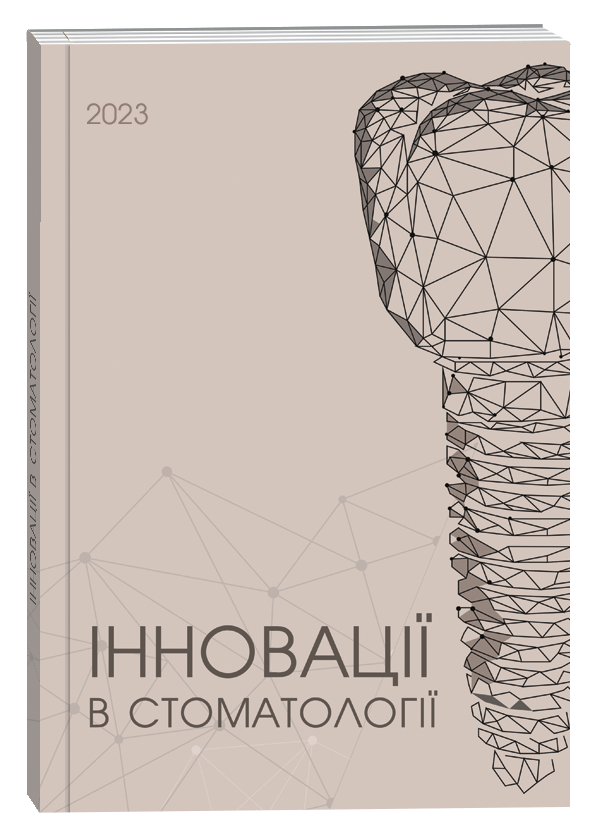MODERN EXPERIENCE IN DENTAL MANAGEMENT AND PREVENTION OF SALIVARY-GLAND DISEASES IN MIDDLE-AGED ADULTS
DOI:
https://doi.org/10.35220/2523-420X/2025.2.30Keywords:
salivary glands; sialosis; sialoadenitis; middle age; preventionAbstract
In adults aged 35–60 years, salivary-gland pathology arises from a multifactorial interplay of endocrine, metabolic, autoimmune, radiation-related and infectious- inflammatory factors. Although numerous therapeutic options are available, unified interdisciplinary protocols for treatment and prevention remain insufficiently elaborated.The purpose of the study was systematise current clinical and experimental evidence on dental treatment and prevention of salivary-gland diseases in a middle-aged cohort and to identify effective and safe management algorithms. Materials and methods. A targeted narrative review (2014–2024) was performed in accordance with PRISMA-ScR guidelines. Searches were conducted in PubMed, Scopus, Web of Science, Google Scholar and national repositories. Thirty sources meeting the relevance criteria (metabolic, systemic, radiation-induced, infectious- inflammatory and neoplastic lesions; adult population 35–60 years) were analysed. Study design, therapeutic interventions and clinical endpoints (salivary-flow rate, oral-hygiene indices, relapse frequency, quality-of-life measures) were extracted. Research results. Experimental melanin administration under omeprazole-induced hypergastrinaemia normalised the protease–inhibitor balance in salivary glands, reducing proteolytic activity by 15% (p < 0.05). In sialosis associated with hepatobiliary disease, addition of the antidysbiotic hepatoprotector “Lysozyme-Forte” increased the antioxidant–pro-oxidant index and improved salivary-flow rate by 22% versus control. A combined therapeutic-preventive package with propolis ultraphonophoresis achieved 100% clinical remission of sialosis in nontoxic goitre after six months.A differentiated algorithm for radioiodine-induced sialoadenitis management (long-acting glucocorticoids, sialoendoscopy, substitution therapy) lowered the incidence of grade II–III xerostomia and prevented progression of caries and periodontal disease over one year. Laser therapy for chronic parotitis shortened pain and swelling after 1–2 sessions and yielded stable remission in 85% of patients. Conclusions. Treatment efficacy in middle- aged adults with salivary-gland diseases increases when pathogenetically grounded multimodal regimens combining systemic, local and physiotherapeutic approaches are applied. Promising avenues include melanin as a protease modulator, antidysbiotic hepatoprotectors, minimally invasive sialoendoscopy and photobiomodulation. Further randomised trials are required to standardise protocols and evaluate long-term safety.
References
Сухомлин А.А. Експериментальна корекція меланіном протеїназно-інгібіторного дисбалансу слинних залоз в умовах гіпергастринемії. Актуальні проблеми сучасної медицини: Вісник української медичної стоматологічної академії. 2014. Vol. 14. № 2 (46). P. 152–154.
Борис Г.З., Фурдичко А.І. Клінічне обґрунтування використання антидисбіотичного засобу Лізоцим-форте у комплексному лікуванні хворих із захворюванням слинних залоз на тлі гепатобіліарної патології. Український журнал медицини, біології та спорту. 2019. Vol. 4. № 1. P. 183–188.
Чеботарь О.А., Лавренюк Я.В. Клінічна оцінка ефективності лікування сіалозу, що виникає на тлі нетоксичного зобу. Вісник морської медицини. 2018. Vol. 4 (81). P. 108–117.
Копчак А.В., Макаренко В.А. Ефективність комплексного лікування радіойод-індукованого сіалоаденіту та його вплив на стан стоматологічного здоров’я пацієнтів (проспективне контрольоване дослідження). Вісник стоматології. 2024. Vol. 126. № 1. P. 102–111.
Auttara-Atthakorn A., Sungmala J., Anothaisin-tawee T., Reutrakul S., Sriphrapradang C. Prevention of salivary gland dysfunction in patients treated with radioiodine for differentiated thyroid cancer: A systematic review of randomized controlled trials. Frontiers in Endocrinology. 2022. Vol. 13. Article 960265. DOI: 10.3389/fendo.2022.9602652.
Clement S.C., Peeters R.P., Ronckers C.M., Links T.P., van den Heuvel-Eibrink M.M., Nieveen van Dijkum E.J.M., et al. Intermediate and long-term adverse effects of radioiodine therapy for differentiated thyroid carcinoma: A systematic review. Cancer Treatment Reviews. 2015. Vol. 41. № 10. P. 925–934. DOI: 10.1016/ j.ctrv.2015.09.001.
Upadhyaya A., Meng Z., Wang P., Zhang G., Jia Q., Tan J., Li X., Hu T., Liu N., Zhou P., Wang S., Liu X., Wang H., Zhang C., Zhao F., Yan Z. Effects of first radioiodine ablation on functions of salivary glands in patients with differentiated thyroid cancer. Medicine. 2017. Vol. 96. № 25. Article e7164. DOI: 10.1097/MD.0000000000007164.
Kim J.W., Kim J.M., Choi M.E., Kim S.K., Kim Y.M., Choi J.S. Does salivary function decrease in proportion to radioiodine dose? Laryngoscope. 2020. Vol. 130. № 9. P. 2173–2178. DOI: 10.1002/lary.28342.
Sadiç M., Korkmaz M., Gültekin S.S., Demircan K. Alterations in ADAMTS12 gene expression in salivary glands of radioiodine-131-administered rats. Nuclear Medicine Communications. 2016. Vol. 37. P. 1010–1015. DOI: 10.1097/MNM.0000000000000556.
Klein Hesselink E.N., Brouwers A.H., de Jong J.R., van der Horst-Schrivers A.N., Coppes R.P., Lefrandt J.D., Jager P.L., Vissink A., Links T.P. Effects of radioiodine treatment on salivary gland function in patients with differentiated thyroid carcinoma: A prospective study. Journal of Nuclear Medicine. 2016. Vol. 57. № 11. P. 1685–1691. DOI: 10.2967/jnumed.115.169888.
Mester A., Piciu A., Lucaciu O., Apostu D., Piciu D., Voina-Tonea A. Assessment and care of oral lesions for patients who undergo radioiodine treatment for thyroid cancer. The American Journal of the Medical Sciences. 2021. Vol. 361. № 1. P. 8–13. DOI: 10.1016/j.amjms.2020.07.035.
Adramerinas M., Andreadis D., Vahtsevanos K., Poulopoulos A., Pazaitou-Panayiotou K. Sialadenitis as a complication of radioiodine therapy in patients with thyroid cancer: Where do we stand? Hormones (Athens). 2021. Vol. 20. № 4. P. 669–678. DOI: 10.1007/s42000-021-00304-3.
Zeng Q., Mandel L. Radioactive iodine-induced hyposalivation: Case report. Journal of Oral and Maxillofacial Surgery. 2019. Vol. 77. № 9. P. 1837–1840. DOI: 10.1016/j.joms.2019.03.032.
Li X., Su J.Z., Zhang Y.Y., Zhang L.Q., Zhang Y.Q., Liu D.G., Yu G.Y. [Title in Chinese]. Beijing da xue xue bao: Yi xue ban (Journal of Peking University. Health Sciences). 2020. Vol. 52. № 3. P. 586–590. DOI: 10.19723/j. issn.1671-167X.2020.03.029.
Gilat H., Vainer I., Avishai G., Maymon S.L., Alkan U., Hod R., Robenshtock E., Friedman S., Shpitzer T. Radioiodine therapy-induced sialadenitis versus chronic idiopathic sialadenitis – Presentation and outcomes. Head & Neck. 2021. Vol. 43. № 9. P. 2724–2730. DOI: 10.1002/ hed.26741.
Sunavala-Dossabhoy G. Radioactive iodine: An unappreciated threat to salivary gland function. Oral Diseases. 2018. Vol. 24. № 1–2. P. 198–201. DOI: 10.1111/ odi.1277423.
Ciarallo A., Rivera J. Radioactive iodine therapy in differentiated thyroid cancer: 2020 update. AJR American Journal of Roentgenology. 2020. Vol. 215. № 2. P. 285–291. DOI: 10.2214/AJR.19.22626.
Dreyer N.S., Lynggaard C.D., Jakobsen K.K., Pedersen A.M.L., von Buchwald C., Grønhøj C. Xerostomia. Ugeskrift for Læger. 2021. Vol. 183. № 27. Article V11200814. (In Danish).
Łysik D., Niemirowicz-Laskowska K., Bucki R., Tokajuk G., Mystkowska J. Artificial saliva: Challenges and future perspectives for the treatment of xerostomia. International Journal of Molecular Sciences. 2019. Vol. 20. № 13. Article 3199. DOI: 10.3390/ijms2013319926.
Kopchak A.V., Makarenko V.А. A differentiated approach to complex treatment of radioiodine-induced salivary gland lesions. Modern Medical Technology. 2023. Vol. 4. P. 12–20.
Швець А.І., Константінова А.С., Макаренко В.І. Дослідження лікувальної дії препарату «Фітоліт» при калькульозному сіалоаденіті. Матеріали VII Всеукраїнської науково-практичної конференції з міжнародною участю «Полтавські дні громадського здоров’я» 26 травня 2023 року 2023. P. 117.
Якименко Д.О. Вплив олії амаранта на взаємозв’язок структурно-функціональних змін слинних залоз і імунної системи у тварин з моделлю синдрому Шегрена. Вісник морської медицини. 2018. Vol. 4 (81). P. 123–129.
Гаврілов В.О., Флегонтов В.В. Спосіб естетичного лікування ретенційних кіст малих слинних залоз нижньої губи. Загальна патологія та патологічна фізіологія. 2014. Vol. 9. № 4. P. 76–81.
Дмитрієва А.А., Рузін Г.П., Резепова К.Р. Лазеротерапія у комплексному лікуванні хворих з хронічними паротитами. PhD thesis. Українська медична стоматологічна академія. 2019.
Маланчук В.О., Бродецький І.С. Розповсюдженість новоутворень слинних залоз за даними клініки НМУ імені О.О. Богомольця в період 2014–2018 рр. Журнал Національної академії медичних наук України. 2019. Vol. 25. № 1. P. 93–96.
Da Silva L.P., Serpa M.S., Viveiros S.K., et al. Salivary gland tumors in a Brazilian population: A 20-year retrospective and multicentric study of 2292 cases. Journal of Cranio-Maxillofacial Surgery. 2018. Vol. 46. № 12. P. 2227–2233. DOI: 10.1016/j.jcms.2018.09.028.
Franzen A.M., Kaup Franzen C., Guenzel T., Lieder A. Increased incidence of Warthin tumors of the parotid gland: A 42-year evaluation. European Archives of Oto-Rhino-Laryngology. 2018. Vol. 275. № 10. P. 2593–2598. DOI: 10.1007/s00405-018-5092-3.
Luers J.C., Guntinas-Lichius O., Klussmann J.P., et al. The incidence of Warthin tumors and pleomorphic adenomas in the parotid gland over a 25-year period. Clinical Otolaryngology. 2016. Vol. 41. № 6. P. 793–797. DOI: 10.1111/coa.12694.
Wang X.D., Meng L.J., Hou T.T., et al. Tumors of the salivary glands in northeastern China: A retrospective study of 2508 patients. British Journal of Oral and Maxillofacial Surgery. 2015. Vol. 53. P. 132–137. DOI: 10.1016/j.bjoms.2014.10.008.
Скакун Л.М. Рак слинних залоз: епідеміологія, клініко-морфологічні особливості і методи лікування. Шпитальна хірургія. 2014. № 3. P. 79–84.








